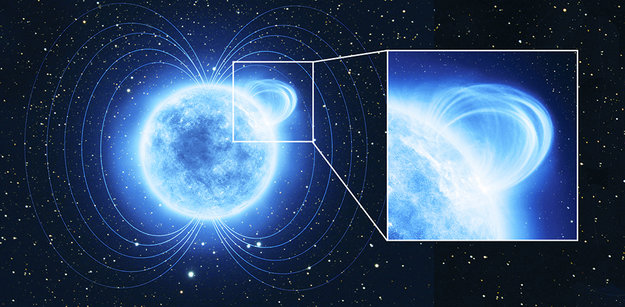More details, including arxiv links, at:
Max-Planck-Gesellschaft
A magnetar at the heart of our Milky Way
Radio astronomers use pulsar with strong magnetic field to investigate supermassive black hole
Astronomers have discovered a magnetar at the centre of our Milky Way. This pulsar has an extremely strong magnetic field and enables researchers to investigate the direct vicinity of the black hole at the heart of the galaxy. An international team of scientists headed by the Max Planck Institute for Radio Astronomy in Bonn have, for the first time, measured the strength of the magnetic field around this central source and were able to show that the latter is fed by magnetic fields. These control the inflow of mass into the black hole, also explaining the x-ray emissions of this gravity trap.
The discovery of a pulsar closely orbiting the candidate supermassive black hole at the centre of the Milky Way (called Sagittarius A*, or Sgr A* in short) has been one of the main aims of pulsar astronomers for the last 20 years. Pulsars, those extremely precise cosmic clocks, could be used to measure the properties of space and time around this object, and to see if Einstein's theory of General Relativity could hold up to the strictest tests.
Shortly after the announcement of a flaring X-ray source in the direction of the Galactic centre by NASA's Swift telescope, and the subsequent discovery of pulsations with a period of 3.76 seconds by NASA's NuSTAR telescope, a radio follow-up program was started at the Effelsberg radio observatory of the Max Planck Institute for Radio Astronomy (MPIfR).
"As soon as we heard about the discovery of regular pulsations with the NuSTAR telescope we pointed the Effelsberg 100-m dish in the direction of the Galactic centre", says Ralph Eatough from MPIfR's Fundamental Physics Research department, the lead author of the study. "On our first attempt the pulsar was not clearly visible, but some pulsars are stubborn and require a few observations to be detected. The second time we looked, the pulsar had become very active in the radio band and was very bright. I could hardly believe that we had finally detected a pulsar in the Galactic centre!" Because this pulsar is so special, the research team spent a lot of effort to prove that it was a real object in deep space and not due to man-made radio interference created on Earth.
Additional observations were performed in parallel and subsequently with other radio telescopes around the world (Jodrell Bank, Very Large Array, Nançay). "We were too excited to sleep in between observations! We were calculating flux densities at 6am on Saturday morning and we could not believe that this magnetar had just turned on so bright." says Evan Keane from the Jodrell Bank Observatory. Other collaborations worked at different telescopes (Australia Telescope/ATCA, Parkes and Green Bank Telescope). A research paper on the ATCA results by Shannon & Johnston appears in this week's issue of the British journal MNRAS.
http://www.eurekalert.org/pub_releases/ ... 081413.php
http://www.nrao.edu/pr/2013/magfield/
